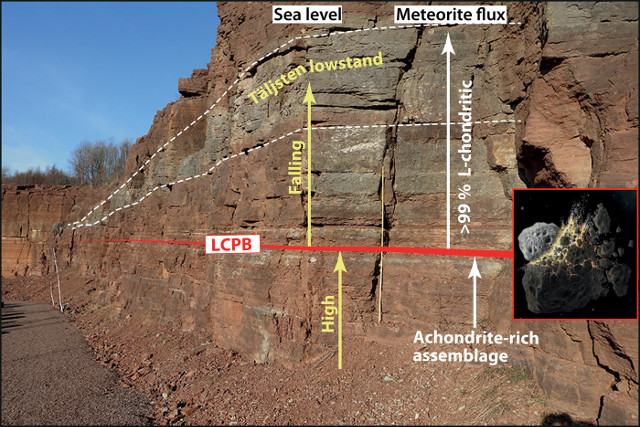
An article published in the journal “Science Advances” reports a study linking the fragmentation of an asteroid between Mars and Jupiter about 466 million years ago to what is known as the Great Ordovician Biodiversity Event (GOBE). A team of researchers led by geologist Birger Schmitz of Lund University, Sweden, analyzed micrometeorites from that era. The ones of L-type chondrite type that can be linked to the fragments of that asteroid date back to the time of the ice age that marked the beginning of that biodiversity.
At Lund University, Birger Schmitz runs the astrogeobiology laboratory, which brings together various disciplines to link the history of the Earth to the larger astronomical realm by searching for extraterrestrial materials. In this research, those materials are micrometeorites dating back to the Ordovician period. Schmitz has been investigating this material increase for a long time and since the 1990s over 100 micrometeorites have been found only in the area of Kinnekulle, in southern Sweden.
The image (Photo Birger Schmitz, Lund University; illustration by Don Davis) shows a section of Kinnekulle rocks in which the red line represents the stratigraphic level of the sediments that match the moment of the fragmentation of the asteroid between Mars and Jupiter. At the same level, the grain size of bioclastic limestone fragments indicate the onset of a gradual drop in sea level. In the inset, an artistic illustration of the asteroid’s fragmentation.
The measurement of extraterrestrial helium present in the Kinnekulle sediments was a key to the research. That’s because the dust that arrived on Earth from the asteroid belt was hit by the solar wind that enriched it with helium that has isotopic proportions different from the helium normally found on Earth. The study of helium isotopes in the sediments, together with that of rare metals often found in asteroids, proves that they came from space.
The analyzes indicate an enormous increase in the flow towards the Earth of extraterrestrial materials shortly, in geological terms, before the beginning of the Great Ordovician Biodiversity Event. According to the reconstruction of Birger Schmitz’s team, an asteroid with an estimated length of 150 kilometers was torn to pieces and fragments started spreading across the solar system. A part of those fragments reached the Earth in an amount sufficient to shield a part of the sunlight generating a progressive global cooling that triggered the beginning of an ice age.
At the beginning of the Great Ordovician Biodiversity Event, it’s possible that life forms capable of surviving in those colder conditions or that adapted to them also took advantage of the fact that colder water holds more dissolved oxygen in it. The increase in glaciers caused the levels of the seas to fall isolating or almost isolating various seas and creating new niches for biological diversification.
The researchers also included a discussion regarding the current global warming situation. Among the possibilities suggested to combat it there’s the idea to capture an asteroid to be used to generate dust to be put into the Earth’s atmosphere. Philipp Heck, one of the authors of the article, is very cautious in this regard because if such a project went wrong it could make the situation even worse.
As for the Great Ordovician Biodiversity Event, the connection with the dust that came from space could be the smoking gun in investigating a key period in the evolution of life on Earth.

